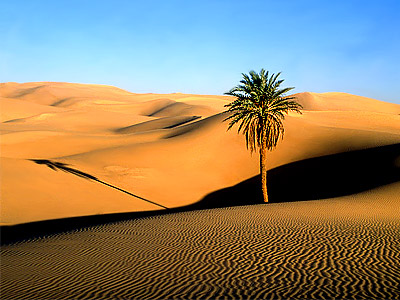Biodiversity of Thar Desert is responsible for the diversified habitat and ecosystem, human culture, vegetation and animal life in this arid region. There are stretches of sand in Thar region that are interspersed by hillocks and sandy and gravel plains. About 23 species of lizard and 23 species of snakes are found in this region and there are many who are endemic to the region. Some of the wildlife species that are fast getting extinct in other parts of India are also found in the desert in large number such as the Great Indian Bustard, the Blackbuck, the Indian Gazelle and the Indian Wild Ass in the Rann of Kutch. These animals have actually evolved great survival strategies. The size of these animals is smaller than other similar animals living in different conditions, and they are nocturnal. There are also many other factors responsible for the survival of these animals in the deserts. Due to the lack of water in the region transformation of grassland into agriculture has been very slow. The protection provided to them by the local people, the Bishnois, is also a major factor. Some of the other mammals of the Thar area include a sub species of Red Fox and a wild cat, the caracal.
This region is home to 141 species of migratory and resident birds of the deserts. One can get to see eagles, harriers, falcons, buzzards, kestrel and vultures, short-toed Eagles Tawny Eagles, Spotted Eagles, Laggar Falcons and kestrels. Apart from these animals there are also a number of reptiles in the area.
The Indian Peafowl is an occupant breeder in the Indian subcontinent particularly in the region of Thar Desert in India. The peacock is chosen as the national bird of India. It can be seen sitting atop the Khejri or Peepul trees in Deblina or villages.
Natural Vegetation of Thar Desert
The natural vegetation of this area is categorized as Northern Desert Thorn Forest that occurs in tiny clumps scattered openly. The size and density of the patches increase from west to the east after the increase in the amount of rainfall. The natural vegetation of the region consists of tree, herb and shrub species.
Tree species of Thar Desert
 Some of the essential tree species in the region of Thar Desert include: Acacia senegal, Albizia lebbeck, Acacia jacquemontii, Acacia leucophloea, Azadirachta indica, Salvadora oleoides, Tecomella undulata, Anogeissus rotundifolia, Prosopis cineraria and Tamarix articulate. Some of the small shrubs and trees are Calligonum polygonoides, Acacia jacquemontii, Ziziphus zizyphus, Ziziphus nummularia, Balanites roxburghiiCalotropis procera, Suaeda fruticosa, Aerva tomentosa, Clerodendrum multiflorum, Crotalaria burhia, Leptadenia pyrotechnica, Lycium barbarum,Grewia populifolia, Euphorbia neriifolia, Cordia rothii, Commiphora mukul, Maytenus emarginata, Capparis deciduas and Mimosa hamata.
Some of the essential tree species in the region of Thar Desert include: Acacia senegal, Albizia lebbeck, Acacia jacquemontii, Acacia leucophloea, Azadirachta indica, Salvadora oleoides, Tecomella undulata, Anogeissus rotundifolia, Prosopis cineraria and Tamarix articulate. Some of the small shrubs and trees are Calligonum polygonoides, Acacia jacquemontii, Ziziphus zizyphus, Ziziphus nummularia, Balanites roxburghiiCalotropis procera, Suaeda fruticosa, Aerva tomentosa, Clerodendrum multiflorum, Crotalaria burhia, Leptadenia pyrotechnica, Lycium barbarum,Grewia populifolia, Euphorbia neriifolia, Cordia rothii, Commiphora mukul, Maytenus emarginata, Capparis deciduas and Mimosa hamata.
Herbs and grasses of Thar Desert
Eleusine compressa, Dactyloctenium scindicum, Cenchrus biflorus, Cenchrus setigerus, Panicum turgidum, Panicum antidotale, Lasiurus hirsutus, Cynodon dactylon, Sporobolus marginatus, Saccharum spontaneum, Dichanthium annulatum, Cenchrus ciliaris, Desmostachya bipinnata, Erogrostis species, Sorghum halepene, Citrullus colocynthis, Ergamopagan species and Phragmitis species.
There are actually eleven national parks in the Thar Desert area; two of the well known names areas are the Rann of Kutch and Nara Desert Wildlife Sanctuary. Others names include the Desert Natioanl Park, Jaisalmer which is an example of the ecosystem of the Thar Desert. Some of the endangered species like the Great Indian Bustard, Blackbuck, Chinkara, Fox, and Bengal Fox are also found in the region. The massive fossilized tree trunks and seashell in this park record the geological history of the desert. Tal Chappar Sanctuary is a tiny wildlife park in Charu District 210 km from Jaipur, in the Shekhawati region. This sanctuary is the safe heaven to a large number of Balckbuck while the caracal and fox can also be seen along the typical; avifaunas like Partridge and sand grouse. Jalore Wildlife Sanctuary is yet another small sanctuary that is personally owned where a bulk population of the rare and endangered wildlife is present that includes Asian-Steppe Wildcat, Leopard, Zird, Desert Fox and herds of Indian Gazelle.
Greening Desert of Thar Desert
The soil of the Thar Desert is dry and most part of the soil is prone to wind erosion. High velocity of the wind lead to the soil erosion, depositing of neighbouring fertile lands and shifting of sand dunes with the region of desert, which causes blockage of roads and railway tracks and burial of fences. One of the solutions to this problem can be of shifting sand dunes with relevant plant species and planting shelterbelts and windbreaks. It also provides security from cold and hot desiccating winds and the invasion of sands.
There are little limited tree species apt for planting in the Thar Desert Region and they grow very slowly. The beginning of exotic tree species in the desert for agricultural estate has turn out to be essential. The Rajasthan Canal system is the major irrigation scheme of the Thar Desert and is conceived to reclaim it and also to check spreading of the desert to fertile areas.



















